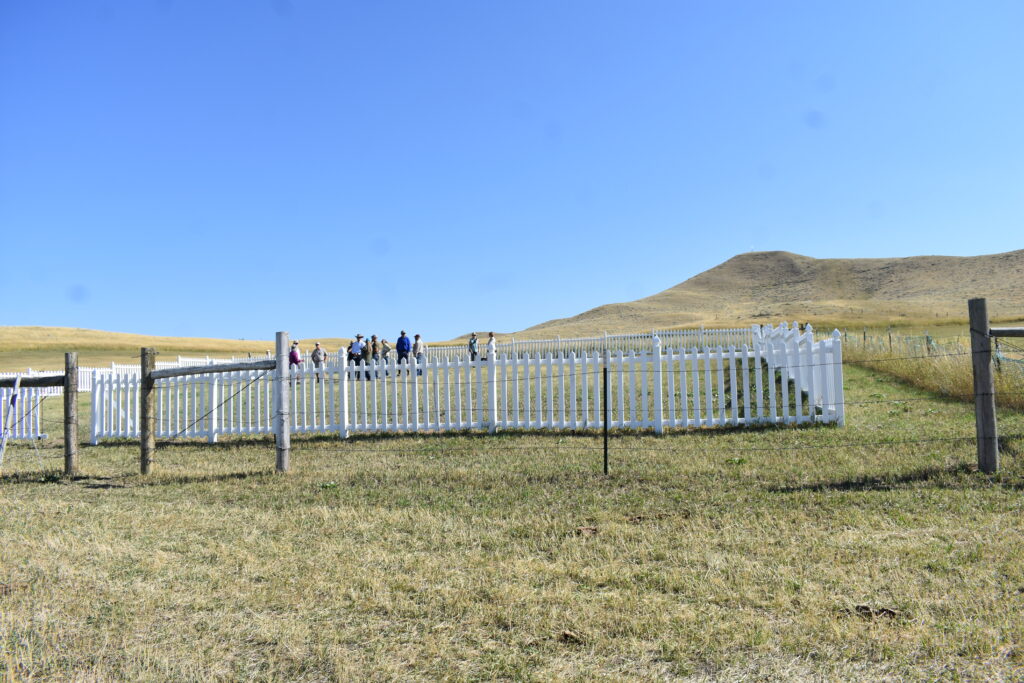alt
Fort Phil Kearny Cemetery Tour Held on Sunday

On Sunday, Sept. 18 Spencer Morris, Fort Phil Kearny Bozeman Trail Association member led a tour of the Fort Phil Kearny Cemetery. Around 40 people attended and took the mile and half round trip hike from the Fort to the cemetery.
Morris talked a little about Fort Phil Kearny. He said that at this time in 1866 they were still building walls. On Oct. 31 the fort was completed and dedicated. There was a parade ground, a flagpole, or mast, and a band shell for the fort band. There were office quarters, cavalry and infantry barracks.

He also explained the blue sign that said, powder magazine. He said that structure held the cannon balls, powder, rifles and all the munitions for the fort. It could be used for a more shocking purpose as well.
He added that in 1866, it was interesting that when they were building the fort to protect settlers, they made the time to build a cemetery at the start. You would think that housing and barracks would be the first things built, but they laid out a cemetery. It was a rather bleak outlook, Morris added.
The cemetery was a 100 foot by 100-foot square. He said at one time there was an obelisk in the cemetery, but is it now gone. He said it had probably been broken up and the pieces may have been used by homesteaders.

Many cemeteries are set on an east west direction, but in this one the bodies are buried in north south direction. He added that graveyards are part of a churchyard, while cemeteries are not.
Through the years, the cemetery has been farmed over, but now it is protected by a white fence. It is kept mowed out of respect. There are two remaining grave sites, the sites two young children of homesteaders that were buried there.
Morris said that after the Fetterman fight, the 76 frozen bodies of the soldiers were brought back to the fort and buried in a mass grave, in three levels. “How do I know that?” Morris asked. “Eighteen years after the battle the army decided to exhume the bodies and rebury them at the Little Big Horn Battlefield on Last Stand Hill.”

He quoted from an interview with an area homesteader in 1935, who shared his experience exhuming the bodies.
The bodies on the top tier were badly decomposed. The second layer wasn’t in bad shape, and they could see the mutilations that had been inflicted on the bodies. Most of the bodies from third tier were well preserved.
Morris added that many times it was impossible to find all of the remains, due to forces of nature as well as the land having been farmed and plowed at one time. Other forces were at play as well. Morris said that local ranchers helped with the exhuming of the bodies. They weren’t always respectful of the dead.
He said there are undoubtedly still bones buried in the cemetery, but most of the soldiers now rest in peace, or pieces, at the Custer National Cemetery, having been moved once again from Last Stand Hill.

Due to the fact that no one really knows if there are still any other remains left from the era of the fort, as well as the fact there are still two graves remaining, the cemetery is still hallowed and sacred ground.


Ira roadifer
September 21, 2022 at 7:03 pm
Thank you. I was wondering if the cemetery was for real. How did they know about the children and do they know we’re they are buried. I wish I could have made it to the talk.